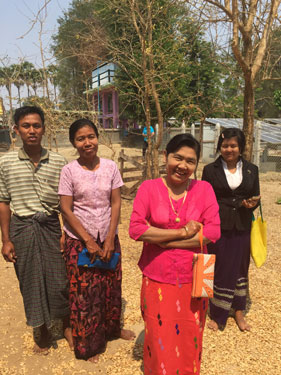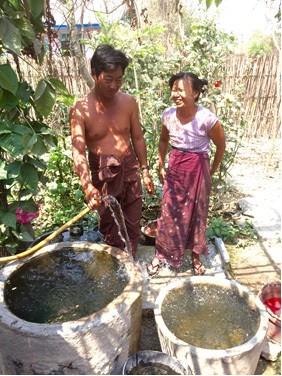Solar pumps bring safe water to families in Myanmar
2016-06-03
By Emily Bamford
In a Myanmar community affected by drought, easy access to safe water is hard to come by. With support from UNICEF and the Government, the village purchased a solar powered water pump and now all households get water pumped straight to their homes.

© UNICEF Myanmar/2016/Bamford Daw Khin, 60, stands beside members of the Village Water and Sanitation Committee. Behind them is the solar water pump system that now ings water to every household.
MAGWAY REGION, Myanmar/HONG KONG, 3 June 2016 – Mon Taw village is a community located in Pauk Township, north-western Myanmar. Most regions of the country receive large amounts of rainfall each year, but Magway regularly experiences droughts, which are being exacerbated by the impacts of climate change.
As a result, safe water is often only available 100 metres below the surface of the ground, making it very difficult to access.
“We used to rely on a hand pump which didn’t work properly in the summer because the water level would drop so low,” says Daw Khin, 60, who is both a headmistress at the local school and the Manager of the Village Water and Sanitation Committee. “It meant we’d have to travel really far to collect water. It was a real burden for us.”
Solar-powered water
In 2014, to help make safe water more accessible, UNICEF collaborated with the State Government to help the community secure a solar-powered water pump system. The village came together to contribute 40 per cent of the funds for the purchase and construction of the system.
The innovative solar pump system uses light energy to pull safe water up from deep below the earth’s surface. The water then flows into a large storage tank which stores enough water to ensure sufficient provision throughout the day. Gravity allows water to flow freely through a pipe system, directly to households.
Compared to hand-pumps or diesel powered pumps, solar pumps rarely eak down. But just in case, the Village Water and Sanitation Committee collects a small fee from each household once per month, based on their water consumption (an average of HK$7.8 (US$1) per month per household).

© UNICEF Myanmar/2016/Bamford Umar Khim and Daw Mya San stand next to their new piped water source in Mon Taw community.
This means that the community is now completely self-reliant in terms of water supply. And because of the initial investment made by the community, they feel a strong sense of ownership and responsibility for the system. The piped connection (directly to the household) has also had a major impact in terms of convenience.
“We don’t mind paying for our water now as it’s so much more convenient than before,” says Daw Khin. “One dollar a month is affordable for everyone in the community, and because the pump hasn’t oken down yet – we have more than HK$7,800 (US$1,000) available in our reserve fund. We’re hoping to use some of the balance for health and education projects.”
Reaching more communities
One of the households benefiting from the improved water supply is the Khim family. “It’s so great now that we have water flowing directly to our home,” says Umar Khim and Daw Mya San. “It has made our day-to-day lives so much easier, giving us time to focus more on family and other things that make us happy!”
In 2015-2016, UNICEF Myanmar is supporting the installation of 15 new systems across the country which aim to reach around 20,000 people. This is helping to contribute towards the Government’s strategy to reach 70 per cent of the population with piped water by 2030 (only 8 per cent of the population in Myanmar currently have piped water access).









